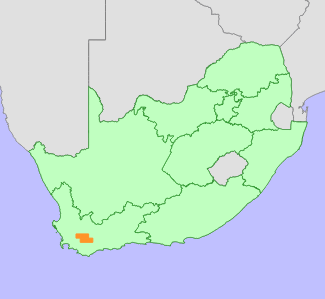|
Scientific Name | Aspalathus candicans Aiton f. |
Higher Classification | Dicotyledons |
Family | FABACEAE |
Synonyms | Aspalathus sericea Lam. |
National Status |
Status and Criteria | Endangered B1ab(ii,iii,iv,v) |
Assessment Date | 2012/12/21 |
Assessor(s) | A.L. Schutte-Vlok, D. Raimondo & L. von Staden |
Justification | EOO 1073 km², between three and five locations continue to decline due to ongoing habitat loss to urban and agricultural expansion. |
Distribution |
Endemism | South African endemic |
Provincial distribution | Western Cape |
Range | Worcester to Bonnievale. |
Habitat and Ecology |
Major system | Terrestrial |
Major habitats | Robertson Karoo, Breede Shale Renosterveld |
Description | Flats or low hills with clay soils. |
Threats |
| This species is threatened by ongoing habitat loss to agricultural expansion (mainly vineyards) in the Breede River Valley, and urban expansion around Worcester. |
Population |
Population trend | Decreasing |
Assessment History |
Taxon assessed |
Status and Criteria |
Citation/Red List version | | Aspalathus candicans Aiton f. | EN B1ab(ii,iii,iv,v) | Raimondo et al. (2009) | |
Bibliography |
Dahlgren, R. 1966. Revision of the genus Aspalathus. II. The species with ericoid and pinoid leaflets. 5. The Aspalathus carnosa, aciphylla, pachyloba, arida, pinguis, spinosa and sanguinea groups and some other groups. Opera Botanica 11(1):7-266.
Dahlgren, R. 1988. Crotalarieae (Aspalathus). In: O.A. Leistner (ed). Flora of southern Africa 16 Fabaceae, Part 3 Papilionoideae, Fascicle 6:1-430. National Botanical Institute, Pretoria.
Goldblatt, P. and Manning, J.C. 2000. Cape Plants: A conspectus of the Cape Flora of South Africa. Strelitzia 9. National Botanical Institute, Cape Town.
Raimondo, D., von Staden, L., Foden, W., Victor, J.E., Helme, N.A., Turner, R.C., Kamundi, D.A. and Manyama, P.A. 2009. Red List of South African Plants. Strelitzia 25. South African National Biodiversity Institute, Pretoria.
|
Citation |
| Schutte-Vlok, A.L., Raimondo, D. & von Staden, L. 2012. Aspalathus candicans Aiton f. National Assessment: Red List of South African Plants version 2024.1. Accessed on 2025/10/26 |
 Comment on this assessment
Comment on this assessment


